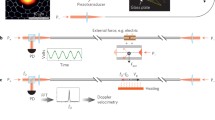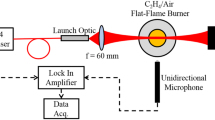Abstract
Numerous optical probe designs to measure particle volume fraction have been proposed in the literature. Unfortunately, almost all of them suffer from an ill-defined measurement volume, poor sensitivity or require frequent and tedious calibration. We propose an improvement in the design of a dual optical fibre probe. It has a well-defined measuring volume and a near-linear sensitivity. A general calibration theory for optical fibre probes is also proposed. The design and the theory have been tested in a simple experimental set-up with encouraging results.








Similar content being viewed by others
Abbreviations
- a :
-
probe glass thickness (m)
- b :
-
glare diameter (m)
- d p :
-
particle diameter (m)
- dS :
-
surface element (m2)
- D :
-
optical fibre diameter (m)
- f :
-
maximum packing signal, function of distance to the probe (V)
- g :
-
radial distribution, function of particle volume fraction
- h :
-
probe sensitivity, function of distance to the probe (V)
- I :
-
intensity of light reflected off a particle (V)
- l :
-
light ray length (m)
- N :
-
number of elements
- n p :
-
number of particles
- p :
-
penetration depth of light distribution, function of distance and particle volume fraction (m−1)
- q :
-
glare correction, function of probe geometry and particle size
- r :
-
distance to the probe surface (m)
- r ′:
-
distance from the probe surface to the first particle in a given direction ( θ, φ) in a given suspension (m)
- R :
-
probe receptivity to light, function of angle of incidence and distance to particle
- S :
-
probe response signal (V)
- S 0 :
-
probe response at zero volume fraction of particles (V)
- S dense :
-
probe response at maximum packing of particles (V)
- V cyl :
-
cylinder volume (m3)
- V p :
-
particle volume (m3)
- z :
-
independent length variable (m)
- α p :
-
volume fraction of particles
- α p,max :
-
volume fraction of particles at maximum packing
- β :
-
angle between incident and receiving optical fibre (rad)
- δ :
-
exponent
- γ :
-
exponent
- θ :
-
altitude angle in spherical coordinates (rad)
- φ :
-
azimuthal angle in spherical coordinates (rad)
- λ :
-
mean free path of light (m)
- σ :
-
dimensionless probe response signal
- ξ :
-
dimensionless reciprocal mean free path of light
- η :
-
dimensionless distance to probe surface
- ζ :
-
independent dimensionless length
- ~:
-
instantaneous value
- <>:
-
expectancy value
References
Almstedt AE (1985) Measurement of bubble behaviour in a pressurized fluidized bed burning coal using capacitance probes, part 2. In: Proc 8th Int FBC Conf, Houston, USA, pp 89–98
Bellino I, Bergougnoux L, Misguich-Ripault J, Firpo JL (2000) Particle size effects on an optical fiber sensor response. Powder Technol 115:68–74
Hartge EU, Li Y, Werther J (1986) Analysis of the local structure of the two phase flow in a fast fluidized bed. In: Basu P (ed) Circulating fluidized bed technology. Pergamon, Oxford, pp 153–160
Johnsson H, Johnsson F (2001) Measurements of local solids volume-fraction in fluidized bed boilers. Powder Technol 115:13–26
Krohn DA (1986) In: DePaula RP, Udd E (eds) Fiber optic and laser sensors IV, SPIE vol 718, p 2
Lischer DJ, Louge MY (1992) Optical fiber measurements of particle concentration in dense suspensions: calibration and simulation. Appl Opt 31:5106–5113
Maxwell JC (1892) Electricity and magnetism. Clarendon, Oxford
Olowson PA, Almstedt AE (1990) Influence of pressure and fluidization velocity on the bubble behaviour and gas flow distribution in a fluidized bed. Chem Eng Sci 45:1733–1741
Reh L, Li J (1991) Measurement of voidage in fluidized beds by optical probes. In: Basu P (ed) Circulating fluidized bed technology, vol 3. Pergamon, New York
Rensner D, Werther J (1991) Modeling and application of a fiber optical measuring system for higher concentrated multiphase flow. In: Proc 4th int conf laser anemometry, ASME, Cleveland, pp 753–761
Tontrup C, Gruy F (2000) Light backscattering by fine nonabsorbing suspended particles. Powder Technol 107:1–12
van Wachem BGM, Shouten JC, van den Bleek CM, Krishna R, Sinclair JL (2001) Comparative analysis of CFD models of dense gas–solid systems. AIChE J 47:1035–1051
Werther J (1997) Measurement techniques in fluidized beds. In: Proc 4th world conference on experimental heat transfer, fluid-dynamics and thermodynamics, Brussels, 2–6 June 1997
Werther J, Hage B, Rudnick C (1996) A comparison of laser Doppler and single-fibre reflection probes for the measurement of the velocity of solids in a gas-solid circulating fluidized bed. Chem Eng Proc 35:381–391
Acknowledgements
The authors wish to thank SCA Hygiene Products, AstraZeneca R&D Mölndal and the SSF programme Multiphase Flow for their financial support. We also thank Lars Jernqvist and Uno Hansson for building the probe and the electronics.
Author information
Authors and Affiliations
Corresponding author
Rights and permissions
About this article
Cite this article
Rundqvist, R., Magnusson, A., van Wachem, B.G.M. et al. Dual optical fibre measurements of the particle concentration in gas/solid flows. Exp Fluids 35, 572–579 (2003). https://doi.org/10.1007/s00348-003-0703-0
Received:
Accepted:
Published:
Issue Date:
DOI: https://doi.org/10.1007/s00348-003-0703-0




